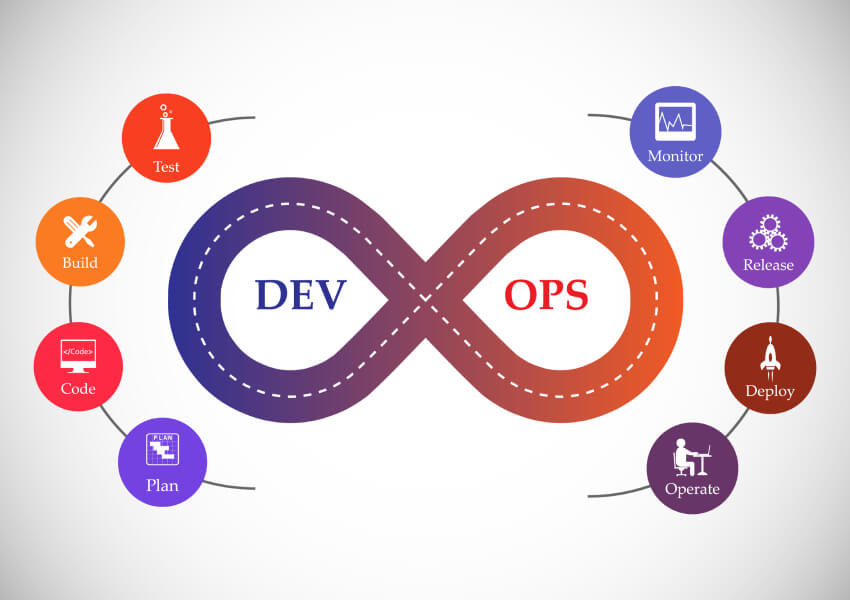
Microsoft Azure DevOps
The buzz around DevOps has been increasing steadily over the past year, and it is expected to attain its peak in 2019. According to Statista, in 2018, 17% of the respondents said that their company has embraced DevOps as compared to 10% of the respondents in 2017.
DevOps is the new mantra for shipping products quickly, and organizations are embracing it to come out of the eternal delayed delivery cycle. DevOps is not a set of tools that make product development simpler but a set of guidelines bring about score changes in your work ethics. DevOps recommends the implementation of concepts like automation, single delivery pipelines, continuous integration, continuous deployment, and complete security.
What is Microsoft Azure DevOps?
Azure DevOps is an initiative by Microsoft to integrate all the different tools provided by it to its Azure clients for different stages of the product development life cycle. Through its new tools, Microsoft Azure DevOps empowers its clients to release high-quality projects quickly, without compromising on quality.
1. Deliver Innovation with Microsoft Azure DevOps
When an organization adopts Microsoft Azure DevOps, its focus shifts from managing end to end product development process to generate innovative ideas for business growth. This is possible because Azure DevOps tools make product design, development and release much more streamlined.
2. Simplify and speed cloud development
Organizations use the cloud to facilitate high quality and faster development at reduced cost and resource utilization. Using Azure DevOps delivery pipelines further simplifies and speeds up cloud development. You want to develop a new application or modify/scale up an existing application, Azure DevOps is the easiest way to develop, deploy and distribute cloud applications.
3. Increase reliability and repeatability
With Azure DevOps tools that manage infrastructure, provide a uniform environment and ensure continuous deployment, you can focus on coming up with innovative ideas rather than struggling with managing and securing processes. This improves your reliability and ability to replicate success across multiple clients.
4. Automation
Azure DevOps automates every task that can be automated. Automation makes continuous integration and continuous deployment of features fast, secure and bug-free. Automation also allows teams to forget about the boring and time consuming repetitive tasks and focus on coming up with innovative ideas instead.
5. Develop and deploy your way
Azure DevOps process is highly flexible and equipped to accommodate your unique requirements. Using the various tools provided by Azure DevOps, you can define your own processes that enable you to develop and deploy solutions your own way.
6. Profitability and growth
Azure DevOps drives business growth and profitability because development cycles are shorter, the number of potential bugs is minimum, new features can be added quickly, sometimes within hours, and process automation frees up time for teams to focus on innovation.
Start DevOps with Azure
DevOps has become the industry standard for software development because it empowers organizations to not only develop new software quickly but also add new features frequently. Amazon deploys every second and Netflix deploys thousands of times every day. Companies like Nordstrom have increased their release frequency from twice a year to once a month, all thanks to the adoption of demo in their organizations.
If you are yet to embark on a journey of DevOps in your organization, starting with Azure DevOps is highly recommended. As they say, well begun is half done. This is what you get when you adopt Azure DevOps:
- Simplified development pipeline
- Tools suited to the expertise of your team
- Improved communication and collaboration between your teams
- Deploy, maintain and distribute apps from the cloud
- Expertise of Microsoft with DevOps
Azure DevOps Model
Azure DevOps model is implemented in these steps:
1. Plan and track
The most important element of is your devil model is tracking each and every activity of your development pipeline. Industry standards practice is in processes like Agile and Kanban boards should be used to visually track the work. visual representation helps all stakeholders to know that development teams progress at any given point in time. This helps in planning and prioritizing further tasks and avoiding critical situations.
2. Develop
Development using your DevOps model is done in small individual packages. When each feature or package is complete a pull request is submitted by the developer, which triggers building and testing of the code automatically. One sure or the package is approved which is merged into the main pipeline and the fork is deleted.
3. Build and test
Building modern products is done through version control systems like Git, which also triggers the build process automatically. The code is rigorously tested and validated to ensure early detection of bugs. This continuous integration of independently constructed artifacts enables the team to Dalibor continuously and deploy whenever required.
4. Deploy
Azure DevOps model supports continuous deployment where the end-to-end process of coding to production is fully automated. Automatic deployment and shows that new features are available to the customers as soon as they are ready from the developers’ end.
5. Monitor and operate
Once the deployment is live, monitoring its performance and collecting information is paramount. Azure DevOps collects live usage data so that your business can make informed business decisions in the future. You can use infrastructure as code as well as policy as code with automatic compliance policies to ensure that the deployments are secure.
Features in Azure That Help Enable DevOps
Azure DevOps is a highly feature-rich offering from Microsoft. Let us look at the new features in Azure that help it to enable DevOps.
1. Azure Boards
They enable the implementation of powerful work managers. When multiple teams are working on the same product, which is the normal scenario for any product development life cycle, Azure boards help track the project with Kanban board, team boards, backlogs, and custom reporting. Each item can be comprehensively traced, allowing for tracking of all the ideas from development to release stages.
2. Azure Repos
Azure DevOps now provides an unlimited cloud-hosted Git repository for your project. Besides hosting, you get support for pull requests for projects of all sizes, intelligent code search, easy forking for effective collaboration, and complete security for your code. You can set up a continuous integration/continuous delivery process to be triggered automatically when any pull request is completed.
3. Azure Pipelines
Azure pipelines help the developers continuously build, test, and deploy from any language to any platform and cloud. When you sign up for Microsoft Azure DevOps you get cloud-hosted plans for Windows, Linux, and macOS with unlimited minutes and 10 free parallel jobs for open source. This underlines Microsoft’s intention of supporting open source development. Azure pipelines also make it easier and faster to build and push images container registries like docker hub and also deploy them to individual hosts or Kubernetes.
4. Azure DevTest Labs
This app helps teams execute planned and exploratory testing for products across desktop as well as web applications. While testing, exhaustive data is collected so that all detected defects can be fixed.
5. Azure Artifacts
Now you can import maven, npm and NuGet package feeds from both public and private sources into your Azure DevOps dashboard. With this, it becomes easier to create and share packages with your team members. Your artifacts are organized sharable and easily integrate to any CI/CD pipeline with a single click.
How to implement Microsoft Azure DevOps in an organization
Even small organizations find it easy and straightforward to adopt Azure DevOps. However, when it comes to large organizations implementing Azure DevOps becomes challenging. There are many stakeholders and DevOps adoption needs a change in mindset. The first thing that you need to do is create a team of people who will be responsible for the implementation. Their prime responsibility will include analyzing existing processes to identify those that can be automated because automation is always the first actionable step towards adopting DevOps.
Getting feedback from the people is another important aspect of implementing Azure DevOps. The feedback provided by Azure DevOps tools tells you what needs to be fixed with the processes but feedback from the employees identifies roadblocks to the adoption of Azure DevOps. As discussed earlier, people are as important as technology or tools used.
The tools available for robust communication channels must be utilized to the fullest so that there is complete transparency in the interaction between all stakeholders. This will identify the problems at the onset and avoid delays in the implementation of Azure DevOps.
DevOps Tools for Continuous Deployment
Reports have suggested that if a company increases its continuous delivery at least by 10%, it’s business revenue increased by more than ten percent. With continuous deployment being such an integral part of DevOps implementation, there are many tools in the market available for use. Each one is the best in itself but the choice of tunes must depend upon the unique problem statement and the overarching goal of developing the application.
Some of the popular DevOps tools include Jenkins, Docker, Jira, AWS CodeDeploy, Ansible, and Chef, etc.
Conclusion
2019 is the year of DevOps implementation and companies of all sizes. When you decide to go for DevOps Consulting Services and implementation in your own organization Microsoft Azure DevOps is the best choice. What you need to have is a plan for implementation, employees that are enthusiastic and excited about the impending changes, and willingness to overcome all challenges on the way to DevOps culture.
Also read:
AWS vs Azure vs Google Cloud: Which is the best cloud platform?






